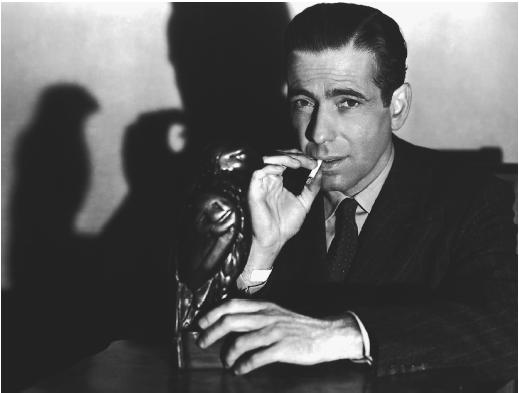Film Noir, The Directors
This weighty paperback volume (over 470 pages) includes an introduction by Silver and essays on 28 directors the pair consider to be crucial to film noir. The essays are written by the editors and a host of over 20 other historians and filmmakers, with brief bios of all the contributors included at the back of the book.
Each essay on a director includes an overview of films deemed to be the director's best and most important films in the genre; a biography; and a list of their noir films or films with noir elements made during their career.
 |
| Humphrey Bogart in John Huston's The Maltese Falcon |
Hollywood's classic era of film noir lasted mostly from the early 1940s to the late 1950s. But film noir is not limited to American-made films or solely that era. The most common elements of film noir are crime, drama, chiaroscuro lighting effects, shadows, seedy locations, and themes of sex and violence. The term film noir, which literally means "black film" in French, was coined in 1946 by French film critic Nino Frank.
Directors included in Film Noir: The Directors: Robert Aldrich, John Brahm, Jules Dassin, Andre de Toth, Edward Dmytryk, John Farrow, Felix Feist, Samuel Fuller, Henry Hathaway, Alfred Hitchcock, John Huston, Fritz Lang, Joseph H. Lewis, Joseph Losey, Ida Lupino, Anthony Mann, Max Ophuls, Gerd Oswald, Otto Preminger, Nicholas Ray, Don Siegel, Robert Siodmak, Jacques Tourneur, Edgar C. Ulmer, Raoul Walsh, Orson Welles, Billy Wilder, and Robert Wise.
Many of the films highlighted should be familiar to readers, whether they realized they were considered film noir. William Covey writes about John Huston's The Maltese Falcon, where Humphrey Bogart's Sam Spade became an iconic noir hero. Huston and Bogart also worked together on the noir classic Key Largo, and did a more comedic take on the form in Beat the Devil.
 |
| Barbara Stanwyck and Fred MacMurray in Billy Wilder's Double Indemnity |
Billy Wilder's Double Indemnity is perhaps the most famous film noir of all time, with Barbara Stanwyck's gorgeous but deadly Phyllis Dietrichson as the ultimate femme fatale. Contributor Sheri Chinen Biesen makes a case for also including Wilder's Sunset Boulevard and The Lost Weekend as noir. William Holden's seedy protagonist Joe Gillis and his voiceover narration (a classic staple of noir films) qualifies, but The Lost Weekend may be more of a stretch. Sometimes the desire to include films that share certain elements with noir classics may dilute how audiences view film noir.
An interesting essay by Jans Wagner on Ida lupino details her various production companies, and how she was able to combine her roles as actress, writer, producer, and director throughout her long Hollywood career. In The Bigamist she became "the first woman in classical Hollywood to direct herself in a starring role." The film was produced by Lupino and ex-husband Collier Young and starred Lupino and Young's second wife, Joan Fontaine. There was probably enough material behind-the-scenes for Lupino to create many more noir intrigues.
 |
| Dana Andrews falls in love with a painting of Gene Tierney in Otto Preminger's Laura |
Chris D. had another great essay on Otto Preminger's Laura. All of the behind-the-scenes confusion and contention about casting, story, and the ultimate ending of the film, creates its own story of suspense. Luckily none of the possible alterations and producer's arguments were ultimately visible on this glossy noir's surface. Reading about Preminger's later film, Bunny Lake is Missing, helped point out some unexpected similarities to Laura — like Laura, for a good portion of the movie the audience is unsure whether the titular character is a phantom or not.
Film Noir: The Directors also includes some directors whose films may not immediately be associated with noir. Geoff Fordham's essay on Alfred Hitchcock points out how the already-deceased-before-the-credits-even-roll Rebecca may be one of film noir's most lethal femme fatales. Hitchcock's movies usually have too much humor to be consider true film noir, but his style, born through his early work in Germany and love of Expressionist films, showcase many elements of the genre — the blurry lines between good and evil, femme fatales and wronged men, as well as stylish and dramatic lighting.
 |
| Judith Anderson and Joan Fontaine in Alfred Hitchcock's Rebecca |
There were a few noir inclusions that may create a little controversy with genre aficionados — Don Siegel's Invasion of the Body Snatchers, Orson Welles's Citizen Kane, and Jacques Tourneur's Cat People, "a supernatural version of the noir femme fatales," although it is undeniable that these films utilize noir elements like flashbacks, voice-over narratiion, and atmospheric lighting.
Film Noir: The Directors is an excellent introduction to the work of some great directors and great films. It certainly makes a perfect resource to study the subject, and a reference of must-see films. An index of all of the films included in the text would have been a welcome inclusion. That is the only element lacking in this otherwise meaty and fascinating look at the work of directors who frequently or occasionally made film noir.

0 comments:
Post a Comment